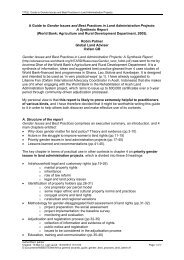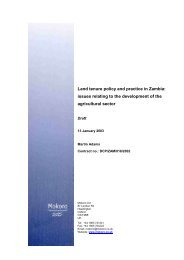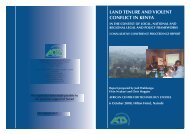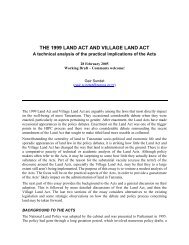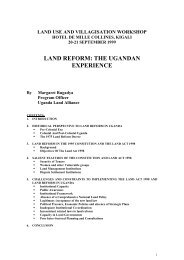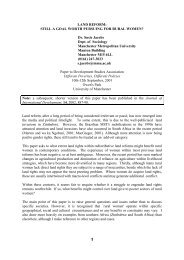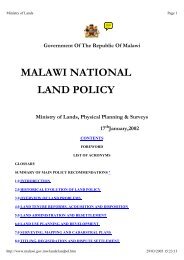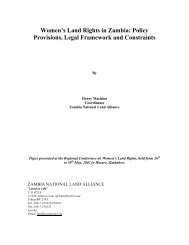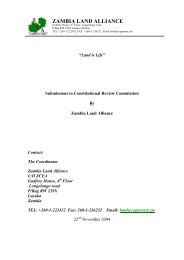Download - Mokoro
Download - Mokoro
Download - Mokoro
- No tags were found...
Create successful ePaper yourself
Turn your PDF publications into a flip-book with our unique Google optimized e-Paper software.
10For instance, planned settlement and agricultural activities were halted at the Mavungenirestitution project in Limpopo where, after delays in disbursement of funds, substantialunplanned settlement on the land (including by non-members) pre-empted these plans,with the result that allocated funds were not disbursed to the claimants for plannedactivities (Manenzhe 2007). Not far away, at Dikgolo, production on household plots forrainfed vegetable and grain production was relatively successful, despite membershaving to commute to and from their land from a neighbouring communal area, butgroup dynamics resulted in the failure of the communal cultivated plot. As nearly half ofproject members ceased to be involved, group-based activities were downscaled whilehousehold-level production was maintained (PLAAS 2007).Another category of unplanned land use is land occupations, including instances whereclaimants, impatient at the pace of land reform, have occupied their land. AtMahlahluvani in Limpopo, for instance, restitution claimants occupied unused portions ofthe land on which they have a pending claim that straddles the old Bantustan border ofVenda (see box 3 below). This case demonstrates the potential benefits of access toland for food production by poor households even where there is no planning and evenin the absence of any external support. Because claimants are using the land before theclaim is settled, formal planning has been stymied.Box 3: Land occupation and use at MahlahluvaniPending negotiations between the Commission and the owners of the various portions ofthe 3,000 ha farm (including a private tea estate), in 1996, claimants moved onto theirland which, besides some forestry, was not being used, and started to cultivate. Morethan 10 years later, 43 farmers (of whom half are women) are cultivating plots of 3hectares or less per household, as far as possible marking out plots that coincide withthe boundaries of their families’ former homesteads and fields. They produce field cropsand vegetables and have established fruit orchards without any external support orregulation, providing a substantial portion of their household food needs, as well asselling off small quantities of maize and other produce locally, including to the local millin exchange for meal. By 2006 almost all these families were able to meet theirhousehold maize consumption needs from their own production and to sell the surplus,and could meet their household requirements for vegetables for up to 10 months in theyear – an impressive compared to many formally planned projects. Despite oppositionfrom wealthier members of the community claim, who are impatient to see the claimsettled and a commercial project put in place, these households continue to occupy anduse this land, an activity that has apparently stalled all formal processes.Sources: PLAAS 2007, Wegerif 2006Commenting more broadly on land reform, where plans for commercial whole-farmsolutions have not been adopted, or have failed, Andrew et al (2003:17) observe that:The use of newly acquired or restored land by resource-poor land reformbeneficiaries tends to follow very conventional uses [similar to those]amongst resource-poor people in communal areas. These land usesinclude individual residential sites, communal grazing for individually orcollectively owned livestock, small-scale low input cultivation for selfprovisioning (and sometimes small amounts of income), and the use ofPolicy Options for Land and Agrarian ReformProgramme for Land and Agrarian Studies, University of the Western Cape




